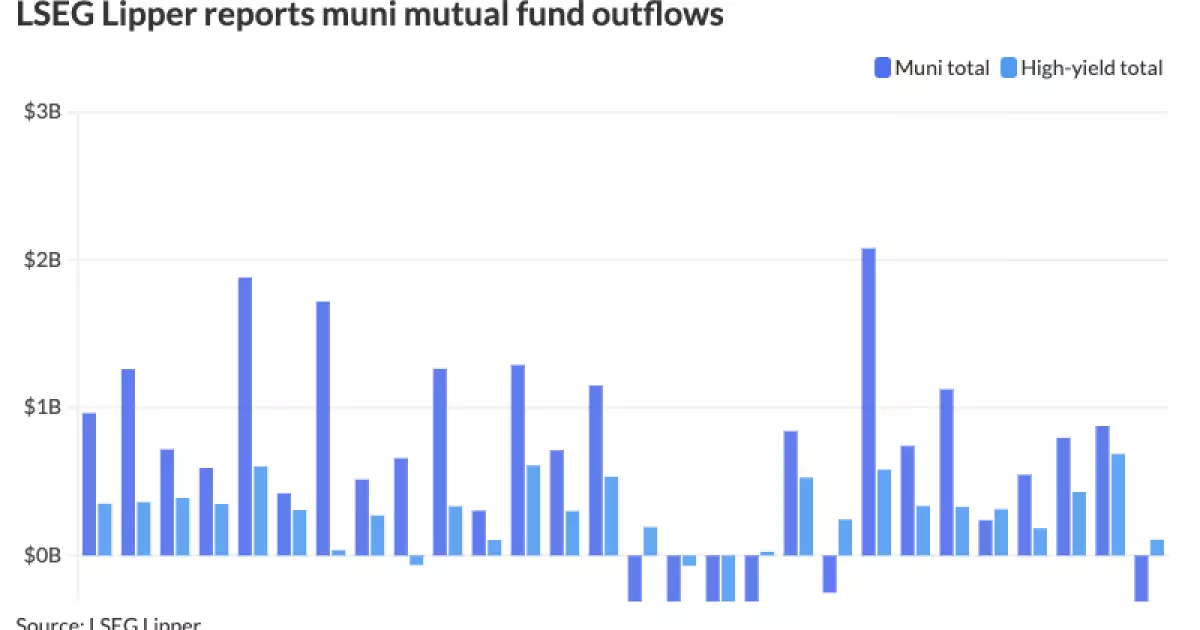Municipal bonds are facing a significant downturn, largely characterized by a persistent imbalance between supply and demand. In recent trading sessions, the sentiment has been adequately captured by Kim Olsan’s mantra of “more supply than demand.” This inadequacy manifests starkly in the increasing Treasury yields and fluctuating equity prices contributing to market volatility. The pricing of municipal bonds declines, with yields across various maturity periods witnessing minor upticks. Notably, the two-year municipal bond yields now hover at 66% of the U.S. Treasury yields, a substantial decrease from earlier projections. These trends prompt an essential query about the market’s future: can municipal bonds regain traction in such a challenging environment?
As observed, excessive supply has necessitated sizeable adjustments in bond pricing, with changes nearing 20 basis points particularly on the long end of the yield curve. The implications unfold on different levels; investors pulling substantial amounts from municipal bond mutual funds, evidenced by the recent $373 million exodus following previous inflows, exemplify the growing investor unease. What does this mean for individual and institutional investors relying on municipal bonds? The perpetual shifts in valuation are becoming less tenable, and risk aversion governs the market atmosphere.
Tax Season and Its Ripple Effects on Market Dynamics
It is pertinent to note that the looming tax season casts a shadow on municipal bonds’ prospects. Historically perceived as secure investments due to their tax-exempt status, these bonds now face threats from policy shifts emanating out of Washington, D.C. Jeff Lipton succinctly articulated the implications of a potential repeal of the municipal tax exemption. In what is increasingly becoming a policy landscape marred by volatility, the possibility of affecting investor appetite for bonds cannot be discounted. Would the allure of tax-free income evaporate under harsher fiscal constraints? The answer lies within the market’s reaction to proposed policy changes and the extent to which they reshape investment strategies.
With heightened discussions around tariffs, trade wars, and tax reforms, markets exhibit a cautious tone. They often react disproportionately to negative information, prompting a noticeable ripple effect through the municipal bond market. If any moves toward the elimination of municipal tax exemptions come to fruition, we may witness a dramatic shift in investor behavior. The challenge for state issuers, who have traditionally enjoyed smooth market access, will be to sustain this momentum amid growing regulatory scrutiny.
Infrastructure Disarray: A Context for Investment Risks
Moreover, the deteriorating state of U.S. infrastructure creates a pressing backdrop for municipal finance issues. As Lipton pointed out, a somewhat apathetic approach to our nation’s infrastructure could threaten both safety and national economic stability. This scenario intensifies the argument for municipal investment, as states face the dual acts of addressing emerging catastrophes and meeting regular maintenance needs. Investors must weigh these urgent infrastructure hurdles alongside the fragility of municipal bonds in today’s environment.
Given the alarming trend of infrastructure disrepair, one must critically reflect on how the current fiscal policies exacerbate the situation. When financial mechanisms designed for public benefit, such as municipal bonds, begin to falter, it reveals a systemic issue. The care with which the bonds are designed and regulated reflects the priorities of policymakers. As an advocate for center-right liberalism, I posit that we cannot shy away from asking government entities to be more accountable for the fiscal instruments they yield—municipal bonds included.
Market Sentiment and the Retail Investor
Retail investors, often the backbone of municipal bond markets, are reeling from this volatility. Each unexpected twist in Treasury yields can cause more significant psychological impacts than one might anticipate in this demographic. Jeff Timlin subtly acknowledged the shaky footing of retail-focused investments during periods of volatility. Abrupt fluctuations tend to leave retail investors feeling cornered. As volatility persists, we may observe a discernible retreat from municipal bonds, hindering capital access to local governments precisely when they need it most.
In this climate, financial advisors and market strategists must recalibrate their recommendations to meet the evolving sentiments of retail investors. The scaling back of interest from retail investors has significant implications, leaving issuers searching for ways to rebalance existing portfolios to retain investor confidence and interest in municipal bonds.
Looking Ahead: The Urgent Need for Policy Intervention
The interplay of market fluctuations and regulatory uncertainties clearly indicates a need for deliberate policy interventions. As we navigate these tumultuous waters, the onus lies not solely on the shoulders of investors and issuers; policymakers must act decisively to create a conducive environment for municipal financing. The focus must shift from short-term fixes to sustainable strategies that will bolster municipal bonds’ attractiveness while concurrently investing in our nation’s critical infrastructure.
The stakes have never been higher. If our leaders ignore these vital signals, the consequences will reflect an immediate lack of confidence and support for this historically essential financing mechanism. In the grander scheme, a proactive stance could ensure municipal bonds regain their stature as a safe haven for billions in investments and, consequently, fortify America’s economic framework.


Leave a Reply